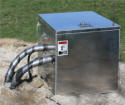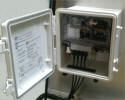The GeoCube is designed to be a trouble-free tool in the field
and the test results are intended to be easy enough to use by
operators with all of the detail necessary for Engineers to
confidently use the test results as part of modeling a
geothermal system. The questions below encompass the
majority of the inquiries that we receive before, during and
after the sale of the GeoCube. If you need something that
we don't cover here, please
contact us.
- I've run a test but am having problems with my computer. Can Precision assist with TC test reports?
- I'm Interested in using the Remote Data Logging. What do I need to know to make it work?
- Is the TC/TRT analysis software available on a standalone basis?
- Can we see examples of what happens when TC tests are disturbed or not set up properly?
- What causes format errors importing data to the GLD TC Analysis Module?
What are the different models of the GeoCube?
The GeoCube is offered in three standard configurations
plus an extended range model that varies based on the depth that the unit can serve. The depth capacity (500'/150m,
850'/260m,
1,100'/335m) is determined by the pump, other hardware, heating elements and electrical system design that are associated with each model. The heating capacity is determined by the amount of power that needs to be injected per foot, per ASHRAE guidelines.
By design, The GeoCube is able to inject 15-25 watts/foot or
49-82 watts/meter of borehole for the model that is selected.
The user can select from multiple heater powers to supply the appropriate power to deliver the heat injection for their specific test borehole.
The
extended range models
are available with all of the same logger configurations using a
larger capacity heat exchanger and additional heating elements
to allow testing of very deep boreholes.
Can the GeoCube perform
TC/TRT tests in all times of
the year?The time of year does not have a direct relationship to
vertical borehole
TC/TRT test. The GeoCube is internally insulated to
minimize impact on the circulating liquid so as not
to be heated or cooled by changes in ambient temperature. The loopfield lines always should be insulated to prevent the loopfield lines from directly exchanging heat with the air. The GeoCube also may be blanketed if desired although the GeoCube does not require additional insulation.. The data analysis takes into account the heat energy from the heating elements and the circulating pump to determine the thermal conductivity/thermal
response results. In other words, the thermal conductivity/response data will accurately reflect the borehole and surrounding soil characteristics regardless of the time of year.
In colder climates, an appropriate antifreeze solution may be necessary to prevent freezing of the liquids when the test is being setup or when the test is being taken down.
The surface temperatures have essentially no short
term effect on boreholes that are deeper than 30
feet, so it is only important to take care of pipes
or liquids which are exposed at the surface.
In subfreezing temperatures, it will be necessary
either put antifreeze into the loop or drain to
sufficient depth to keep the liquid below the frost
line when the test is completed.
What test standards are used by the GeoCube to
determine TC/TRT Data?In North America, ASHRAE guidelines are the accepted standard for determining the thermal conductivity of a borehole. The data analysis that is used by the included software
(GLD) is based on the line-source analysis methodology described in
ASHRAE 111-8TRP and specified in the ASHRAE 2007 HVAC Applications Handbook - Chapter 32.12-32.13 The software produces a report that provides working definitions and explanations of how the data are analyzed and used. The standard test accurately (and optionally) will estimate the undisturbed loopfield temperature and will calculate the soil thermal conductivity of the loopfield. Tests typically are a minimum of 40-60 hours in duration., During the initial 12 hours of the test, heat from the GeoCube fully saturates the borehole,
which provides data for determining the Borehole Thermal
Resistance. During the remainder of the test, heat radiates out from the
saturated borehole and provides data for thermal conductivity determination using the previously mentioned standard line-source method. Precision Geothermal has published a paper titled,
"What to Look for in Thermal Response / Conductivity
Test Services". This document describes procedures,
standards and recommendations for performing Thermal
Conductivity / Thermal Response (TC/TRT) testing.
The GeoCube and related software provide data which may be
analyzed by other methods. Precision Geothermal uses
industry adopted theory for analyzing the test data and any
other analysis methods employed will need to use software or
methods not supplied by Precision Geothermal.
Why is it important to have the Undisturbed Ground Temperature?The undisturbed Ground Temperature is used to calculate the
Borehole Thermal Resistance. This is an important variable
in the design of a loopfield and can only be computed if an
accurate measurement of the Undisturbed Ground Temperature is
recorded prior to disturbing the borehole with the injection of
heat. Typically, the TC test is done a minimum of (5) days
after the drilling or a previous test to allow the borehole to
return to a steady state. Note that the Undisturbed Ground
Temperature is not used in the computation of the Thermal
Conductivity/Resistivity and does not change the TC value.
With the GeoCube, we recommend that the operator start the
datalogger and turn on the circulating pump for about 10 minutes
to completely mix the fluid in the loop and GeoCube to establish
the Average Undisturbed Ground Temperature prior to turning on
any heaters. If this step is not performed, the Average
Undisturbed value may be computed by dropping a manual
temperature probe and measuring the water temperature every 25
feet and averaging the results.
Do I have to
use special grout in the test borehole to get
good TC/TRT data?An experienced driller understands the importance of grouting boreholes and it is a requirement of IGSPHA and NGWA. This answer is intended to respond to the need for a "special" grout when doing
TC/TRT testing.
The borehole may be any size that is appropriate to drill and the borehole should be grouted with material that is suitable for the project. A typical TC/TRT test will try to simulate exactly what will be used for the future loopfield so that the test boring can be incorporated into the production system. The thermal conductivity testing results are not affected by the borehole, since the
TC/TRT. result is a measure of the thermal characteristics of the earth surrounding the loopfield and not the borehole itself. The testing analysis will disregard the first 12 hours of data as the borehole and loop piping heats up and thermally saturates. For the purpose of the testing, a borehole does need some kind of grout because air gaps between the pipe and borehole will effectively insulate the pipe from the borehole, which will likely devastate loopfield performance. The
TC/TRT test does not test the borehole, the loop pipe, the grout or the type of fluid that is used. A
TC/TRT test is testing the thermal characteristics of the earth that surrounds the borehole. The type of grout does however effect the "borehole thermal resistance" which also is calculated from the test and should be representative of the production loopfield design for the project that is being planned. Good commercial loopfield design software can utilize both the Thermal Conductivity
/ Thermal response data AND the Borehole Thermal Resistance data from a test loopfield.
What is a data logger??A data logger is an electronic instrument that records measurements such as temperature, voltage, pressure and events over time.
Typically a data logger is a small, battery-powered device that is equipped with a microprocessor, data storage capacity and sensors. Most data loggers utilize purpose specific software on a PC to start the logger and view the collected data. Data loggers are used in remote areas or anywhere you need to record measurements using a compact, convenient, self contained and battery powered unit. They are ideal for field studies, monitoring, testing and general research. The data logger in the GeoCube eliminates the need for a full PC system to be dedicated to the test site and allows data to be shuttled between the test and the user's computer by means of a physical shuttle or through GSM telemetry to an internet data site.
The GeoCube data logger records data for
the date and time; generator voltage; current; entering and return fluid temperatures;
fluid flow rate; logger battery status. The GeoCube comes with
software to download the datalogger readings in a CSV file and a custom software module from GAIA Geothermal that
can analyze the data on any Windows based PC. This module can read the data logger data and present a time analyzed output which documents the test conditions and outputs with test conclusions for use in geothermal loopfield designs. This data also can be analyzed using a text or spreadsheet program if so desired.
The datalogs may be recorded in either imperial or metric units.
The data logger is specifically matched to the sensors in the
GeoCube.
I've run a test but am having problems with my computer. Can Precision assist with TC test reports?Owners of the GeoCube™ thermal conductivity tester and customers that lease
a GeoCube thermal conductivity testing unit, may optionally contract with Precision Geothermal, LLC for services related to the retrieval and processing of data for an individual TC Test.
Generally, a customer is able to do their own data retrieval and processing with the provided tools. We understand that there are situations which may be related to
customer computers, users or operation that may require assistance beyond regular support. In these situations, Precision Geothermal, LLC will provide, at an additional charge, assistance to retrieve and process the data from a customer test.
This service is NOT design assistance and is NOT intended to substitute for individualized analysis of geology, test conditions or
evaluation of test data for varying subsurface conditions in potential loopfield locations.
In short, Precision Geothermal can assist when the need arises.
The customer is ultimately responsible for their own TC Test but
we can assist with the nuts and bolts of retreiving data and
generating the test report.
I'm Interested in using the
Remote Data Logging. What do I need to know to make it
work?The Advanced GSM Data Logger allows the user to send data to a
datalog website in real time. The web data service is
managed by HOBOLink, the manufacturers of the data logging
hardware. When a GeoCube is purchased with this option,
the user will send data to and from the GeoCube via the HOBOLink
web site as opposed to the use of a manual data shuttle.
This can be extremely useful for monitoring a test while it is
in operation without visiting the site during the test. It
is NOT a substitute for security at the test site and does
require some additional steps to insure that the test is run
properly. Rather than to discuss the advantages of having
the remote data, here are some considerations to consider before
selecting this option:
-
Reliable cell service is
necessary for the remote exchange of data. Not all
areas have good cellular data coverage.
-
The use of the HOBOLink data
service is the responsibility of the customer for service
after the first year. Precision Geothermal will set up
your account and the first year is included in the purchase.
Subsequent service after the first year is the
responsibility of the GeoCube customer.
-
The launch of the data logging
and the logging configuration is performed via the web and
requires that the operator have the necessary equipment on
site to launch and configure the test. An alternate
method requires the person that is operating the test to be
in contact with someone at their home base to launch the
data logging and to do the test configuration. This
procedure could be considered to be more complicated than
running the test with a non-telemetry logger but is the
choice of the company that is running the test.
-
The GSM Data Logger option
does NOT provide the ability to make any adjustments during
the test. The web site can communicate with the GSM
Data Logger but it cannot be used to make adjustments to
heaters, pump operation or etc.
-
The GSM Logger needs to be
charged to maintain communications for the duration of the
test. If you operate a cell phone, you already
understand the importance of having a full charge on your
battery. The variability of the job site power is
generally not condusive for a "universal" charging solution.
The GSM data logger is a powerful
tool for those that must be able to remotely monitor their test
data.
I want
to use shore power instead of renting a generator. Why is
that not recommended?A successful TC/TRT test requires reliable, consistent power in
order to maintain data validity. "Shore Power" or
commercial power can have variations of up to 20% in normal
operations. Utilities deal with wide ranges of load
conditions and it is not uncommon to see brownouts in the system
or power surges that will invalidate the data for your entire
test. Below find a report dialog from using an "unstable"
power source that has exceeded the +/- 10% threshold that was
set for the test: The graph clearly shows the instability
and the resulting "wobbles" in the temperature.
Results like this are clearly unacceptable. We recommend
using a diesel powered generator that is 2X the load for most
optimal results.
Based on the standards from ASHRAE and IGSHPA, a proper test must maintain a maximum +/- 1.5% power input standard deviation from the average power level. Peak variations must be kept at less than 10% of the average power level.
Can I use a 60Hz unit with a 50Hz power source or vice versa?No, the GeoCube is designed and shipped to use a specific type
of power source. Pumps are designed to run at a particular
frequency as well as a specific voltage. The RPM of an
induction motor is based on the frequency of the power source.
GeoCubes are shipped with heating elements that are specifically
rated to produce a specific wattage at their design voltage.
While a GeoCube may operate at a higher/lower voltage or
higher/lower frequency, our ratings are for specific components
to be used in the conditions that they were designed for.
Does it make any difference if I use plain
water instead of an anti-freeze solution?The GeoCube can use plain water or an antifreeze solution. The T.C. test results will not be affected if the environment calls for a solution that involves propylene glycol or ethanol (for example). The GeoCube will maintain adequate flows with antifreeze solutions and the mathematics used to determine the TC value are not affected by whether the test is run with water or antifreeze. If the testing is being conducted in cold climate conditions, steps should be taken to insure that freezing does not occur in the exposed loopfield piping or the GeoCube. Normal ground temperatures will protect the standing liquid below the surface. Exposed portions of the pipe should be protected with antifreeze or kept dry before and after the testing is completed. The GeoCube should be drained completely between uses.
Why do I have to run
tests for 40 hours? Can't I perform shorter tests that are
just as accurate?
 Standards for thermal analysis of the earth surrounding a borehole have been developed over the years by studies which have been used by organizations like ASRAE and IGSPHA. These empirical tests have been established to provide a meaningful and consistent test that does not attempt to extrapolate data beyond the norms that have been established.
A typical borehole and surrounding formation takes 12-20 hours
to saturate at the rate of heat injection that is used.
The TC/TRT value is based on finding a "steady state" slope of the
temperature curve once saturation is achieved. Testing equipment such as the GeoCube and testing organizations that provide
TC/TRT. tests as a third party service are not creating the science but are following the accepted standards. While shorter tests will provide data, the results may not be acceptable by an engineering firm that must use the data to do a project design In addition to the duration of the test, the test also must be continuous and may not be stopped and restarted without waiting for a minimum of (5) days for the earth to rreturn to its native, undisturbed state. Test operators are well advised to take precautions to make sure that generators have sufficient fuel to last the entire duration of the test since any interruption likely will require the test be completely re-run.
For a summary of recommended conditions, please view our
published guidelines:
"What
to Look for in Thermal Response / Conductivity Test Services"
Standards for thermal analysis of the earth surrounding a borehole have been developed over the years by studies which have been used by organizations like ASRAE and IGSPHA. These empirical tests have been established to provide a meaningful and consistent test that does not attempt to extrapolate data beyond the norms that have been established.
A typical borehole and surrounding formation takes 12-20 hours
to saturate at the rate of heat injection that is used.
The TC/TRT value is based on finding a "steady state" slope of the
temperature curve once saturation is achieved. Testing equipment such as the GeoCube and testing organizations that provide
TC/TRT. tests as a third party service are not creating the science but are following the accepted standards. While shorter tests will provide data, the results may not be acceptable by an engineering firm that must use the data to do a project design In addition to the duration of the test, the test also must be continuous and may not be stopped and restarted without waiting for a minimum of (5) days for the earth to rreturn to its native, undisturbed state. Test operators are well advised to take precautions to make sure that generators have sufficient fuel to last the entire duration of the test since any interruption likely will require the test be completely re-run.
For a summary of recommended conditions, please view our
published guidelines:
"What
to Look for in Thermal Response / Conductivity Test Services"
Note: There have been papers published in Europe
suggesting that there are "electrical response method" tests
which can do the same job in less than an hour. At this
time, the industry accepted standards which actually measure and
observe a physical heat exchange are still the trusted method.
With the GeoCube, everything needed to produce a reliable and
accurate test is provided along with the peace of mind that
TC/TRT test will produce accurate results without any additional
exotic equipment or reliance on others to interpret your data.
Why is it best to run 2 minute sample periods? What if I
want to have a longer or shorter sample period?
The sample period of two minutes is recommended to allow the
test to collect sufficient data and also to allow the flow
pulse counter accuracy to produce acceptable results.
For analysis purposes, tests must use at
least one minute samples, but to measure flow
accuracy in the 5-10% range, tests must use two minute
samples or longer. This is a math issue and not a flow
accuracy issue. Because a pulse counter is measuring
an integer value of volume per pulse, the longer sample
period means that flows which are not an exact integer
volume per minute will always have count differences from
one period to another. With the longer sample period,
a difference of one count will be statisticly less
significant against the larger flow count value from a
longer sample. The test requires uniform flows and the
volume per minute value that is computed needs to have an
accuracy of +/- 5% or better for a valid test. With
the expected flows of 7-10 GPM with a typical GeoCube
configuration, a sample period of two minutes or longer is
needed for a good qualitative flow result. Tests can
be run with samples of 2 minutes to 5 minutes with good
results.
If you have accidently set your sample
period to one minute or less, please contact us and we can
assist with correcting the sample period in the recorded
data.
It gets very cold at night and hot during the
day. Don't I have to keep the GeoCube in an insulated trailer?Some users build their GeoCube into an insulated trailer.
Most users that are looking for portability and flexibility do
not. Keep in mind that direct sunlight which impinges on
the GeoCube or especially on uninsulated connecting pipes can
influence the test readings, much like a car that sits in the
hot sun. While we internally insulate the GeoCube with a minimum of 2" of Formular® 250 insulation to shield the sensors and piping
to minimize the influence of outside temperature swings,
an insulating blanket or shading can help further minimize the effect. The exposed loopfield piping,
if uninsulated, is a larger source of temperature variation than the GeoCube. Exposed pipes should be
always be fully insulated and only the shortest necessary amount of pipe to make the connections should be used. The photos below show GeoCubes in operation with insulation applied. If available,
a thermal blanket such as used in construction may be used to cover the pipes for maximum protection. Insulation of the connecting pipes in ALL climates and seasons is the correct way to run conductivity/response tests.
It is always prudent to protect the unit from direct solar radiation during the test.
What are examples of test
results that show problems with the setup and operation of the
GeoCube?While it is
quite easy to do a test correctly, here are some examples of what a correct
datalog will look like along with examples of different problems that
can cause a test to be compromised:
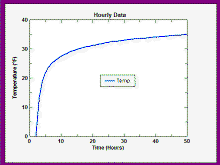
|
This is
an example of a test that has completed properly. |
| |
|
|
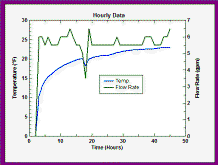 |
Flow and
Temperature plotted. Note issues leading up to
hour 18. User introduced additional water into the
pump well. Loop was likely not purged properly
prior to starting the test. |
|
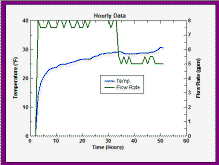 |
Flow rate changed
around 30 hours into test. Likely air bubble. |
|
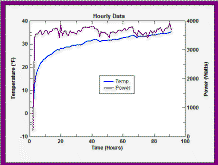 |
Power and
temperature plotted. Generator is poorly
regulated. |
|
 |
Uninsulated loop
pipes exposed to direct sunlight. Causes a small
bump in the temperature profile. |
|
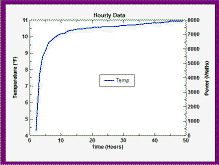 |
Properly run test
in borehole with flowing water. Note the
temperature delta from undisturbed is about half of what
is expected in a normal test. |
|
Can I see examples of different versions of the GeoCube
The GeoCube is offered in three standard configurations
plus an extended range model that vary based on the depth that unit can serve. The depth capacity (400'/120m, 500'/150m, 700'/220m,
850'/260m) is determined by the pump and heating elements that are associated with the model. These units appear
to be very similar from the outside and are the same physical
size. The Extended
Range GeoCube has an external access panel to the heaters. The heating capacity is determined by the amount of power that needs to be injected per foot, per ASHRAE guidelines. The GeoCube is able to inject 15-25 watts/foot
or 49-82 watts/meter of borehole for the model that is selected and the user can select the appropriate power to deliver the heat injection for their specific test borehole.
Our model ratings are based on 60Hz units with 240v available.
50Hz unit heaters are slightly derated. The pumps, electrical system and thermal elements are sized appropriately for the
model of the GeoCube. A high capacity GeoCube may be used for shallower boreholes without any problem by selecting the appropriate power levels with the standard controls available in the unit.
While all three units have the same external configuration, customization options, including multiple finishes, connections and multiple data logging options, are available. All units share the same reliability levels for the basic functionality. Units with the Advanced Data logger feature offer extra protection for the electronic logging unit due to the waterproof internal housing for the electronics. Units that have the anodized chassis will retain their "new" appearance for a greater percentage of their lifetime and can stand up to everyday wear and tear to a greater extent than the polished finish of the standard unit. While the anodized chassis adds extra production to the unit, the performance is 100% the same as the standard finish. The anodized unit (below right) also shows the optional "H" valve assembly, which facilitates reliable start up and tear down by allowing the loops to be fully purged and filled. By reliably eliminating air from the test loop, you protect the integrity of the test and prevent accidental damage to heating elements which could be prematurely damaged by dry operation.
Redundant data sensors are available for every configuration and provide peace of mind during the critical hours of test operation. All redundant measurement channels operate independently and provide a fail-safe for malfunction of any individual data logger channel or unit sensor. This is an internal feature of the GeoCube and is not visible from the outside of the unit but is evident in the additional data points that are collected during the testing.
Our current software has built-in testing to automatically
select sensor pairs from the test data in the event of any
sensor failure or disconnection during a test.
The Advanced Data Logger option with GSM telemetry requires no external antenna and is fully protected inside of the locked housing. This option provides for real-time remote reading of data from your GeoCube during any test conducted in a location with cellular coverage. All loggers collect and store the full data set even if the coverage of the GSM is weak or spotty at the project site.
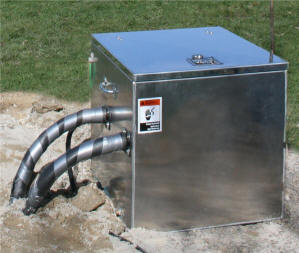
GeoCube - Standard Finish
|
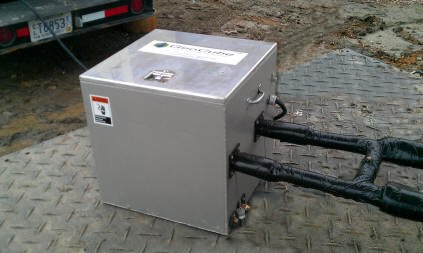
GeoCube - Anodized Finish
|
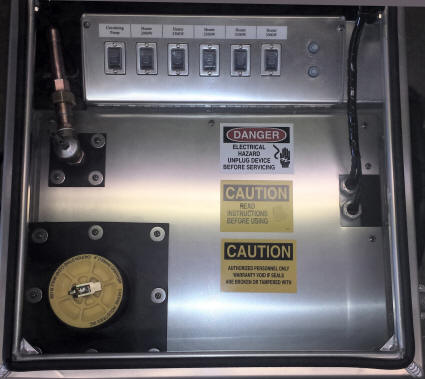
Extended Range Unit Top Panel
|
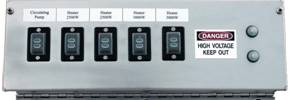
Standard Pump/Heater Panel
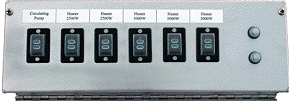
Extended Range Pump/Heater Panel
|

GeoCube with Advanced Data Logger |
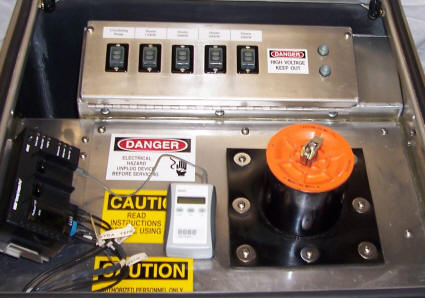
GeoCube with Standard Data Logger
|
Why are there different types of data loggers for the GeoCube?
The loggers in all GeoCubes collect digital data that are stored in flash memory inside of the logger. The standard data logger can store multiple tests and can stay in the unit for extended periods of time for later retrieval. Since a
TC/TRT test involves routine handling in outside environments and with exposure to liquids, some customers prefer to minimize accidental exposures to moisture. The Advanced Data Logger offers a waterproof housing internal to the GeoCube as well as the ability to provide optional telemetry for projects that require real-time readouts of data points. The GSM option for the Advanced Data Logger provides for communication via commercial cellular coverage and data are received by an FTP site for viewing over the web. There are no exposed antennas visible on the GeoCube, which protects the logger unit and eliminates unnecessary attention when the unit is unattended in the field. The subscription service that comes with the GSM logger option provides for secure, backed up data storage that can be read from anywhere in the world.

Advanced Datalogger -
Waterproof Internal Housing |
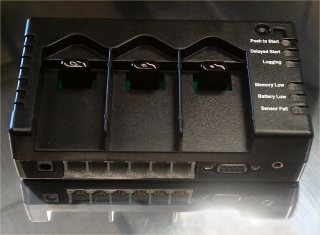
Standard Datalogger
(removeable) |
Does the Convenience Panel Meter Tell Me if the Logger
is Running?
The convenience meter in the panel is for user "CONVENIENCE".
While it provides accurate information regarding the power from
the generator and the operation of the GeoCube heaters, it is
NOT connected to the data logger and does NOT reflect what is
happening with the data logger. The data logger and the
convenience meter are totally independent of each other.
All tests and logging operations must be started using the data
shuttle or the logger. The convenience meter was a user
requested feature for quick monitoring of a test after the data
logger has been properly set up and launched.

For more information on the convenience meter, see the
Convenience Meter Information
What is the Accuracy of the GeoCube?
The GeoCube utilizes a data logger system with sensors that have been tested and approved for the particular logger included with the GeoCube. Depending on the model of the sensor, there will be several types of sensors that are applied in different locations within the unit. Units that employ redundant temperature sensor sets will have multiple sensors that measure loop temperature in multiple locations within the GeoCube. Our sensors exceed the requirements of ASHRAE and IGSHPA standards.
-
Voltage: Accuracy ±1%
from 10% to 130% of rated voltage (AC Potential transformer)
-
Current Sensing:
Linearity accuracy ± 1% from 10% to 130% of rated current
(AC Current Transformer)
-
Flow Meter: Accuracy -
AWWA spec, 97 - 103% (Pulse Output Flow meter)
-
Temperature Sensor: <
+/-0.2 deg C in 0 to 50 deg C operating range - 12 bit smart
sensor
Note: The primary and
redundant sensors will NOT read the exact same temperatures due
to their mounting locations and initial calibration from the
factory. They will exactly track temperature variations to
provide a fallback in the event of sensor failure, data channel
failure or momentary
bubble in the fluid path.
Do I have to periodically recalibrate the GeoCube
temperature sensors?
The simple answer is
NO. This is by
design of the GeoCube and a frequent question from users.
Disclaimer: Any
sensor can be NIST tested for calibration. With our
hardware, we sought to avoid the need for the user to have to go
through this expense. Your calibration results will be
within the specs listed above OR the sensors will not work at
all. Any user that insists on needless "calibration" for
the sensors we use should consider just installing new sensors.
The cost of removal and certification may be more costly than
just installing new sensors and the process is somewhat wasteful
for all involved. There is NO calibration of this type of
sensor.
The GeoCube utilizes RTD type sensors that are
specifically matched to the model of datalogger that is
installed in the GeoCube. The RTD sensors are guaranteed
to maintain drift accuracy during their operational life and the
exact same sensors are also used in other applications that are
temperature critical, such as FDA certified tracking and
traceability. Other TC/TRT test systems often use
thermistor or thermocouple type sensors. The advantage of
the RTD sensors that are used in the GeoCube is that they have
incredibly stable drift characteristics compared to thermistors
or thermocouple sensors. In our application, the main disadvantage of the RTD
sensor is that they can cost 10x to 50x more than thermistors or
thermocouples.
The GeoCube designers chose to use
the RTD type sensors because they do not drift, have a wide
operating accuracy range and because the TC calculations are
based on the delta T between the supply and return and not the
absolute temperature. The critical temperature is between
the sensors. The GeoCube is intended to be user-friendly,
reliable and only require minimal service to guarantee accurate
test results. Each temp sensor is electronically matched
to the data logger, serialized for traceability and is highly
accurate. The sensor is either good or bad. There is
no drift.

Note: As described above in
the accuracy section, the primary and backup sensors will NOT read the exact same temperatures due
to their mounting locations. They will exactly track temperature variations
between pairs to
provide a fallback in the event of connector failure or loss of
channel data in either pair.
What can go wrong with a GeoCube?
Quite simply, the most likely thing to go wrong with the GeoCube itself is damage
caused by improper operation. The internal components have been selected for accuracy,
reliability and rugged use in the field. The mechanical parts most vulnerable to
user-induced damage are the pump and the heating elements.
Introducing mud and
gravel into a loop will kill most pumps. GeoCubes shipped after November 1, 2011 contain
a stainless mesh filter in the standpipe assembly to catch the unknown sediment or gravel
that have inadvertantly found their way into the loop pipe. Units with the 4" standpipe
that were purchased prior to November 2011 can use the new filter, which is available as
a replacement accessory. The mesh filter protects both the
pump and the flow meter.
Accidently restricting flows to the
heaters inside the GeoCube will cause the high-temp cutout circuits to trip or
worse, cause the heating elements to burn themselves out. One of the most common
mistakes is to burn out a heating element by not purging the loopfield and cube
properly prior to turning on the heating elements. Precision Geothermal offers
an optional "H" valve assembly for making it easy to properly purge a system prior
to starting the test but even this requires that the operator take proper steps to
eliminate air from the system.
Just like running an engine without oil - running the GeoCube heaters without properly
proper purging is a near certain guarantee of damage or shortened life. Your GeoCube
is an investment worthy of proper care and operator training. With proper operation,
your GeoCube will provide years of reliable service.
GeoCubes (with the redundant sensor option) shipped after
October 1, 2013 now feature redundant sensor wells in the fluid
flow instead of the pipe mounted sensors in earlier models.
Extended Range GeoCubes feature an external panel for access to
heating elements and a stainless steel heat exchanger manifold.
The driller introduced mud and sand into the test loop.
How can I protect the GeoCube?
 Precision
Geothermal has repaired a number of units that were returned
after failure due to gravel and sand clogging the pump and
causing damage to the pump and the heaters. The current
product design now incorporates a built in, cleanable, stainless
steel filter assembly. This filter will catch sand and
gravel before it can get into
the GeoCube and will help prevent damage from sediment that was
introduced by the driller or through vandalism. Older
units will also accept the new filter system and may be field
upgraded by ordering a replacement filter assembly. Our
filter is rated nominal 140 micron and will stop particulates .0055" and larger while allowing
for full rated pump flows.
Precision
Geothermal has repaired a number of units that were returned
after failure due to gravel and sand clogging the pump and
causing damage to the pump and the heaters. The current
product design now incorporates a built in, cleanable, stainless
steel filter assembly. This filter will catch sand and
gravel before it can get into
the GeoCube and will help prevent damage from sediment that was
introduced by the driller or through vandalism. Older
units will also accept the new filter system and may be field
upgraded by ordering a replacement filter assembly. Our
filter is rated nominal 140 micron and will stop particulates .0055" and larger while allowing
for full rated pump flows.
Why can't I import my CSV file correctly into the Ground Loop Design TC analysis software?
Importing the test result CSV file is generally a straight
forward process. Since the GeoCube is often used in many
parts of the world, the standards for the data format can
present unexpected results. With Windows OS, the Region
selected will set the data format that is seen by the software.
GLD requires that the Time/Date format be in Month/Date/Year
order and the time needs to be Hours/Minutes/Seconds.
Decimals need to specifiy fractions and if your region uses
commas, things will not work correctly. The quickest
workaround is to go the Regions setting in your Windows Control
Panel and select the correct formats or set the Region for
English (US) to see the correct settings. After setting
these settings as specified above, you should eliminate the
import errors that may be occuring.


